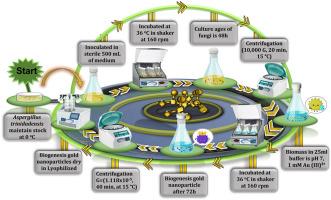Green and sustainable bio-synthesis of gold nanoparticles using Aspergillus Trinidadensis VM ST01: Heterogeneous catalyst for nitro reduction in water
Abstract
In this study, a gold nanoparticles (GNPs) have been successfully fabricated by the bio reduction route using soil extract Aspergillus trinidadensis (VM ST01’ OL587588) fungi as a reducing and capping agent without any solvent interference. The GNPs were grown and stabilized by a two-step one-pot method, without any influence of chemical reactants. Characteristics of prepared GNPs were investigated using various microscopic and spectroscopic techniques. GNPs were roughly spherical in shape. Water dispersion study of GNPs has shown a stable dispersion in a broad range of 2–12 pH. The stirring and precursor salt concentration has influenced the kinetics involved in the fabrication process. Stoichiometric data has shown 3.5 × 1020 gold atoms per gram of biomass with diameters of around 35 nm, as determined with High-Resolution Transmission Electron Microscopy (HR-TEM). Zeta potential and Powder X-Ray Diffraction (P-XRD) studies have elucidated the crystalline nature of GNPs. Presence of participating functional groups were examined with Fourier Transform Infra-Red Spectroscopy (FT-IR). Synthesized GNPs were analyzed for surface morphology by Scanning Electron Microscope (SEM). The thermal stability of the lyophilized GNPs sample and capping of the particle were evaluated with Thermo-Gravimetric Analysis (TGA) and had a residual mass of 25% at 306 °C. The Aspergillus trinidadensis capped GNPs have been demonstrated as an efficient heterogeneous catalyst (AtGNHC) for the reduction of 4-Nitrophenol as a model substrate in water. An isolated yield (>95%) of the reduced product in 4 h has shown the effectiveness of the prepared catalyst.


 求助内容:
求助内容: 应助结果提醒方式:
应助结果提醒方式:


